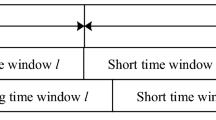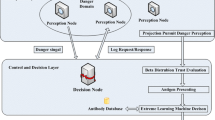Abstract
Data fusion can make use of information from different sources or different representations to describe the target more accurately, which has important research significance. Aiming at the network-running node may be attacked or there is measurement error, this paper comprehensively utilizes the information of each node, and proposes a resource consumption attack identification method based on node multi-dimensional data fusion. First, construct a correlation matrix between nodes, identify normal nodes and possible abnormal nodes, and assign different weights to each node. Then, calculating the support of the node's system attributes for the attack type, and adopting the D-S evidence theory to effectively identify the network attack. The simulations demonstrate the effectiveness and certain advantages of the proposed algorithm.
Access this chapter
Tax calculation will be finalised at checkout
Purchases are for personal use only
Similar content being viewed by others
References
Palmieri, F., Fiore, U., Castiglione, A.: A distributed approach to network anomaly detection based on independent component analysis. Concurr. Comput. Pract. Exp. 26(5), 1113–1129 (2014)
Aborujilah, A., Musa, S.: Detecting TCP SYN based flooding attacks by analyzing CPU and network resources performance. In: International Conference on Advanced Computer Science Applications & Technologies. IEEE (2015)
Harshaw, C.R., Bridges, R.A., Iannacone, M.D. et al.: GraphPrints: towards a graph analytic method for network anomaly detection (2016)
Palmieri, F., Fiore, U.: Network anomaly detection through nonlinear analysis. Comput. Secur. 29(7), 737–755 (2010)
Chaudhary, A., Mittal, H., Arora, A.: Anomaly detection using graph neural networks. In: 2019 International Conference on Machine Learning, Big Data, Cloud and Parallel Computing (COMITCon), Faridabad, India, pp. 346–350 (2019)
Chun-Hui, X., Chen, S., Cong-Xiao, B., Xing, L.: Anomaly detection in network management system based on isolation forest. In: 2018 4th Annual International Conference on Network and Information Systems for Computers (ICNISC), Wuhan, China, pp. 56–60 (2018)
Liu, R., Zhu, Q.: A network anomaly detection algorithm based on natural neighborhood graph. In: 2018 International Joint Conference on Neural Networks (IJCNN), Rio de Janeiro, pp. 1–7 (2018)
Su, Q., Liu, J.: A network anomaly detection method based on genetic algorithm. In: 2017 4th International Conference on Systems and Informatics (ICSAI), Hangzhou, pp. 1029–1034 (2017)
Ateş, Ç., Özdel, S., Yıldırım, M., Anarım, E.: Network anomaly detection using header information with greedy algorithm. In: 2019 27th Signal Processing and Communications Applications Conference (SIU), Sivas, Turkey, pp. 1–4 (2019)
Yager, R.R.: On the aggregation of prioritized belief structures. IEEE Trans. Syst. Man Cybern. Part A: Syst. Hum. 26(6), 708–717 (2002)
Zhao, Y., Jia, R., Shi, P.: A novel combination method for conflicting evidence based on inconsistent measurements. Inf. Sci. 367, 125–142 (2016)
Jiang, W.: A correlation coefficient for belief functions. Int. J. Approx. Reason. 103, 94–106 (2018)
Acknowledgement
This work was supported by National Key R&D Program of China (2019YFB2103202, 2019YFB2103200), Open Subject Funds of Science and Technology on Communication Networks Laboratory (6142104200106).
Author information
Authors and Affiliations
Corresponding author
Editor information
Editors and Affiliations
Rights and permissions
Copyright information
© 2021 ICST Institute for Computer Sciences, Social Informatics and Telecommunications Engineering
About this paper
Cite this paper
Jiao, L., Huo, Y., Ge, N., Ge, Z., Yang, Y. (2021). A Resource Consumption Attack Identification Method Based on Data Fusion. In: Cheng, M., Yu, P., Hong, Y., Jia, H. (eds) Smart Grid and Innovative Frontiers in Telecommunications. SmartGIFT 2020. Lecture Notes of the Institute for Computer Sciences, Social Informatics and Telecommunications Engineering, vol 373. Springer, Cham. https://doi.org/10.1007/978-3-030-73562-3_11
Download citation
DOI: https://doi.org/10.1007/978-3-030-73562-3_11
Published:
Publisher Name: Springer, Cham
Print ISBN: 978-3-030-73561-6
Online ISBN: 978-3-030-73562-3
eBook Packages: Computer ScienceComputer Science (R0)




